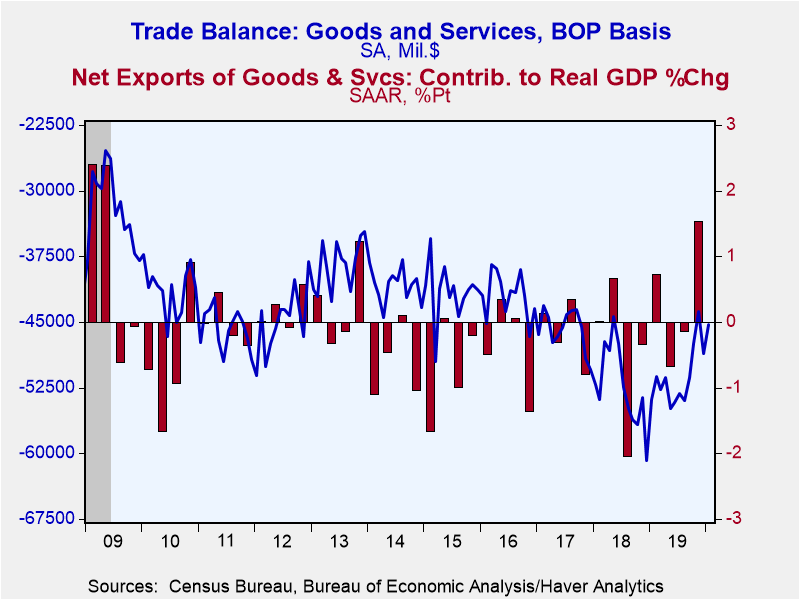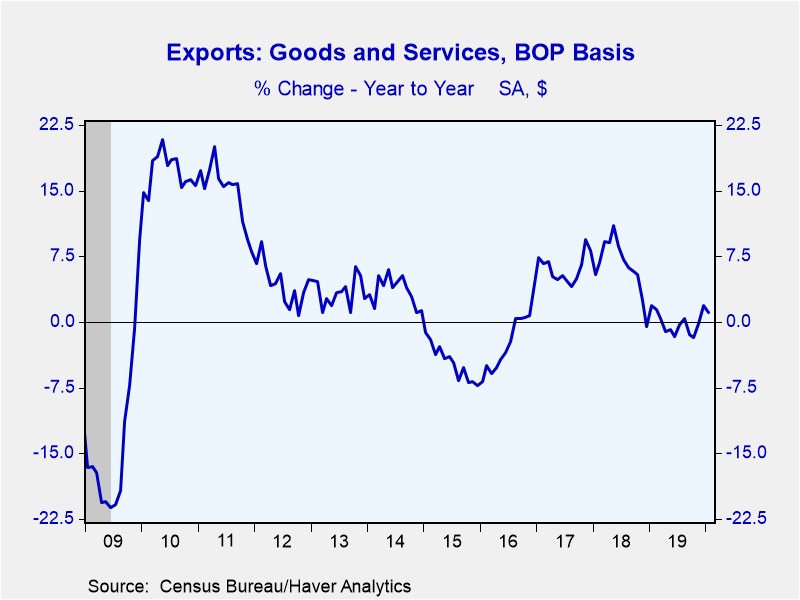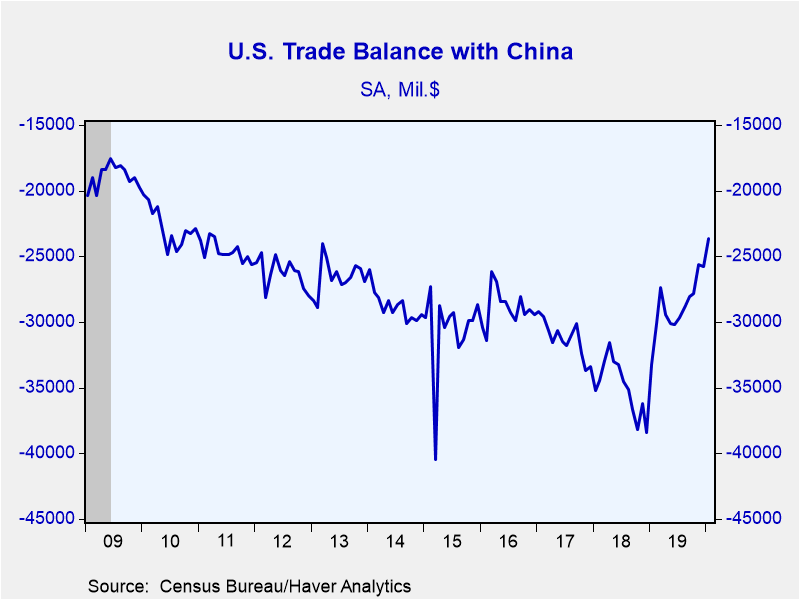 Global| Mar 06 2020
Global| Mar 06 2020U.S. Trade Deficit Narrowed Markedly in January
by:Sandy Batten
|in:Economy in Brief
Summary
• The trade deficit in goods and services narrowed to $45.3 billion in January from $48.6 billion in December. • Exports of goods and services slipped 0.4% m/m while imports fell 1.6% m/m. The U.S. trade deficit in goods and services [...]
• The trade deficit in goods and services narrowed to $45.3 billion in January from $48.6 billion in December.
• Exports of goods and services slipped 0.4% m/m while imports fell 1.6% m/m.
The U.S. trade deficit in goods and services narrowed to $45.34 billion in January from a downwardly revised $48.61 billion in December (originally $48.88 billion). A $47.1 billion deficit had been expected in the Action Economics Forecast Survey. Exports slipped 0.4% m/m (1.1% y/y) after a 0.9% increase in December; imports slumped 1.6% m/m (-2.4% y/y) after a 2.6% m/m jump in December.
The trade deficit in goods narrowed $2.6 billion to $67.0 billion in January, and the services surplus widened $0.6 billion to $21.7 billion. The real (chain 2012$) trade deficit in goods narrowed $2.3 billion to $77.7 billion, auguring a contribution to Q1 GDP from trade.
Exports of goods fell 1.0% m/m (-0.9 y/y) in January, reversing their 1.0% m/m gain in December. The decline was concentrated in the "other goods" category (-13.8% m/m) but exports of capital goods (-2.2% m/m) and industrial supplies (-2.1% m/m) also exhibited meaningful declines. Exports of food rose 5.0% m/m and exports of autos jumped up 6.9% m/m, but failed to completely reverse their 7.7% m/m drop in December. Exports of services rose 0.7% m/m in January.
Imports of goods declined 1.9% m/m (-3.7% y/y) in January after a 3.1% m/m rise in December. Again, weakness in the "other goods" category (-12.7% m/m) was a major factor behind the overall January decline, but weakness was relatively widespread. Imports of industrial supplies slumped 5.4% m/m; auto imports fell 2.3% m/m; capital goods imports declined 1.1% m/m. In contrast, imports of food rose a solid 4.9% m/m. Imports of services fell 0.2% m/m in January.
The goods trade deficit with China narrowed markedly to $23.7 billion in January from $25.7 billion in December. This was the smallest deficit with China since April 2011. U.S. exports to China rose 3.3% m/m while imports fell 5.5% m/m, the eighth consecutive monthly decline. The trade deficit with the European Union narrowed to $13.5 billion in January from $14.0 billion with exports to the EU rising 4.2% m/m while imports from the EU increased 1.6% m/m. The trade deficit with Japan widened to $5.3 billion from $4.4 billion as exports to Japan slumped 15.9% m/m while imports from Japan slid 1.9% m/m.
The international trade data can be found in Haver's USECON database. Detailed figures on international trade are available in the USINT database. The expectations figures are from the Action Economics Forecast Survey, which is carried in AS1REPNA.
| Foreign Trade in Goods & Services (Current $) | Jan | Dec | Nov | Jan Y/Y | 2019 | 2018 | 2017 |
|---|---|---|---|---|---|---|---|
| U.S. Trade Deficit ($ bil.) | 45.34 | 48.61 | 43.79 | 53.82 (01/19) |
616.76 | 627.68 | 550.12 |
| Exports of Goods & Services (% Chg) | -0.4 | 0.9 | 0.6 | 1.1 | -0.1 | 6.3 | 6.2 |
| Imports of Goods & Services (% Chg) | -1.6 | 2.6 | -1.0 | -2.4 | -0.4 | 7.8 | 6.8 |
| Petroleum (% Chg) | -7.8 | 17.5 | -2.6 | 6.8 | -13.9 | 20.8 | 27.2 |
| Nonpetroleum Goods (% Chg) | -1.4 | 2.0 | -1.2 | -4.4 | -0.5 | 7.5 | 5.5 |
Sandy Batten
AuthorMore in Author Profile »Sandy Batten has more than 30 years of experience analyzing industrial economies and financial markets and a wide range of experience across the financial services sector, government, and academia. Before joining Haver Analytics, Sandy was a Vice President and Senior Economist at Citibank; Senior Credit Market Analyst at CDC Investment Management, Managing Director at Bear Stearns, and Executive Director at JPMorgan. In 2008, Sandy was named the most accurate US forecaster by the National Association for Business Economics. He is a member of the New York Forecasters Club, NABE, and the American Economic Association. Prior to his time in the financial services sector, Sandy was a Research Officer at the Federal Reserve Bank of St. Louis, Senior Staff Economist on the President’s Council of Economic Advisors, Deputy Assistant Secretary for Economic Policy at the US Treasury, and Economist at the International Monetary Fund. Sandy has taught economics at St. Louis University, Denison University, and Muskingun College. He has published numerous peer-reviewed articles in a wide range of academic publications. He has a B.A. in economics from the University of Richmond and a M.A. and Ph.D. in economics from The Ohio State University.










